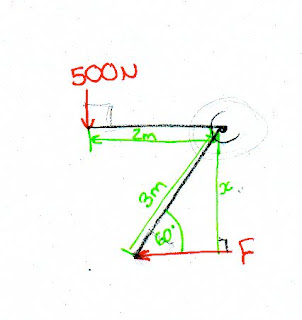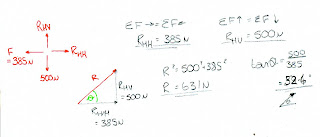Today we did a couple more questions together.
First of all we looked just at moments with forces which are not acting perpendicularly onto the beam. This means that we must resolve these forces into their component parts to find the magnitude of the component which acts perpendicularly to the beam. To help do this, I would have turned this question so that the beam was horizontal, this is how my working is done.
Then we looked at finding a hinge reaction. First of all we needed to use moments to find an unknown force.
Two methods are shown below:
A moment is the force x the perpendicular distance. The 500N force is already acting at right angles to the beam so the anticlockwise moment is simple to calculate. The unknown force is not acting at right angles to the beam it is acting on. So we need to find the perpendicular distance of this force to the hinge.
The alternative is to resolve F into its components and work out how much of F is acting at right angles to the beam. This can then be multiplied by 3 to find the clockwise moment and therefore the magnitude of F.
Now that you know all the forces acting on this beam you can work out the hinge reaction. The very first thing to do is draw an up/down right/left diagram to calculate the components of the reaction, and therefore use pythagoras to work out the hinge, and trig to work out the angle.





No comments:
Post a Comment